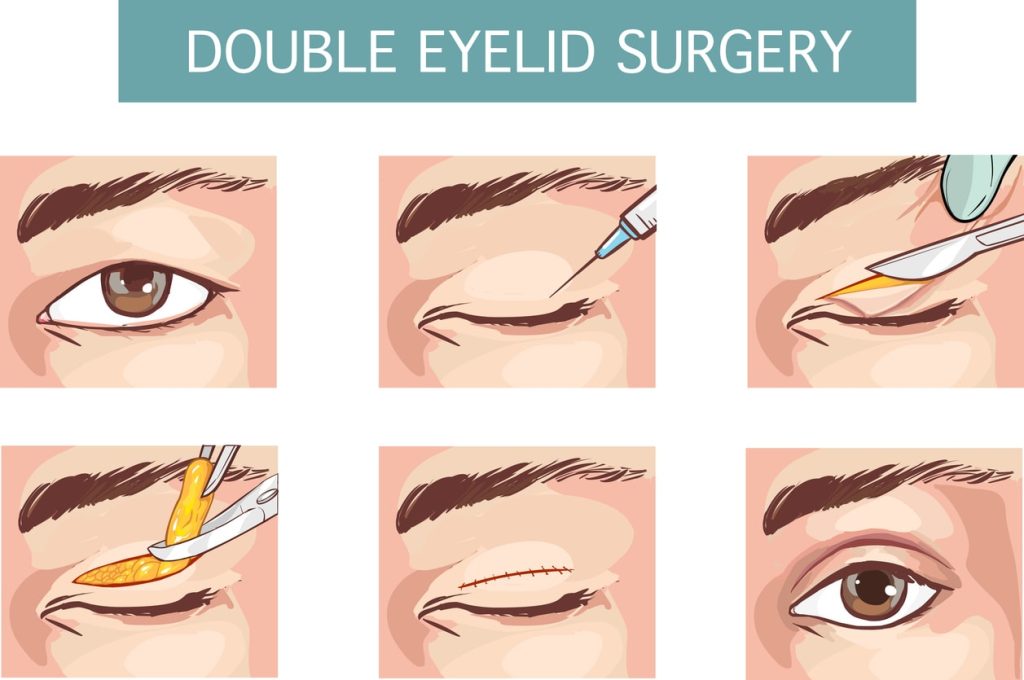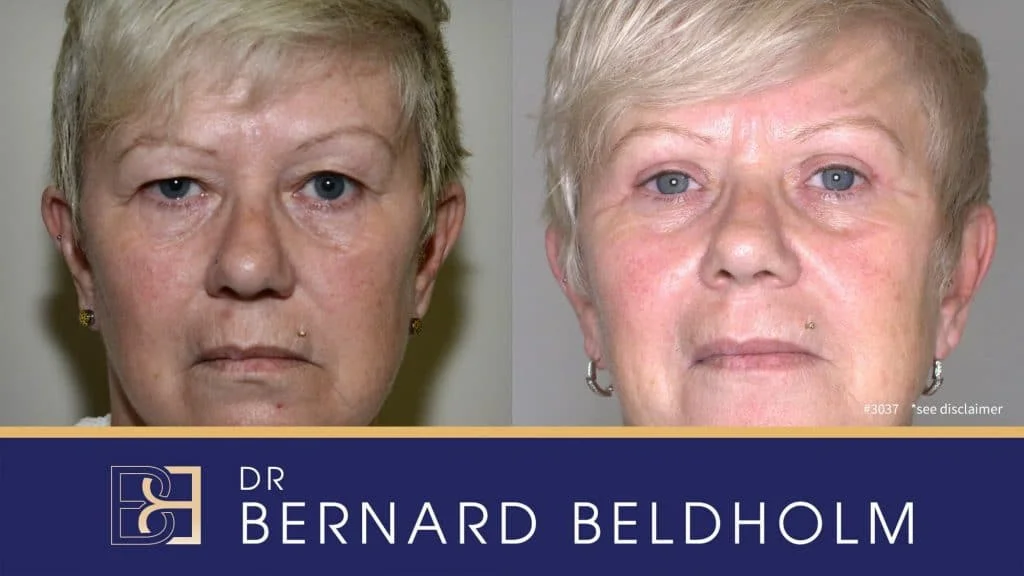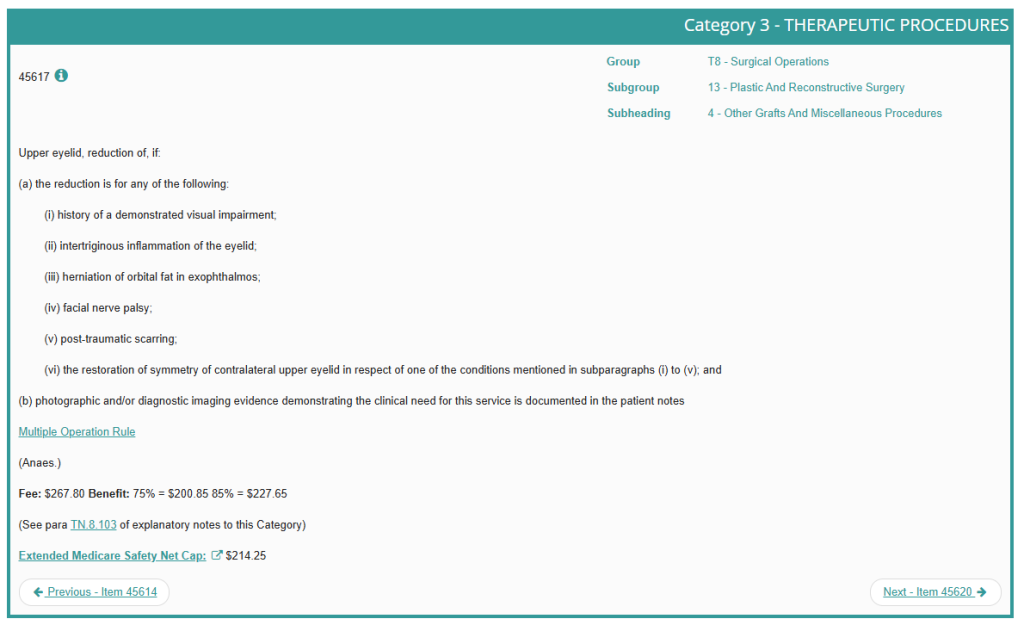Blepharoplasty (Eyelid) Surgery in Newcastle, Maitland & Hunter Valley Australia
Book Online NowBlepharoplasty surgery focuses on the appearance and function of the eyelids by removing excess skin and fat.
Key Takeaways
- Blepharoplasty (eyelid surgery) is designed to remove excess skin and fat around the eyes
- The procedure can be categorised into cosmetic and functional types, focusing on either aesthetic or medical issues that affect vision.
- Recovery requires proper post-operative care and follow-up, with the potential for combining blepharoplasty with other procedures.
Understanding Blepharoplasty
Blepharoplasty, also known as eyelid surgery, is a procedure designed to remove or reconfigure excess skin and fat tissue around the eyes, resulting in a more open appearance. Blepharoplasty not only focuses on the aesthetics of the eyelids but also strengthens muscles and tendons, ensuring both functional and visual benefits.
While blepharoplasty is often performed for cosmetic reasons, it can also address several medical and functional concerns, particularly when loose skin or weakened muscles interfere with vision or eye comfort.
In the upper eyelids, excess skin can cover the lashes and begin to obstruct the line of sight. This typically affects peripheral vision first, a change that can often be confirmed through visual field testing. When the effects are significant enough to interfere with daily activities—such as reading, driving, or using a computer—functional blepharoplasty may be considered medically necessary.
Book Online NowTypes of Blepharoplasty
Blepharoplasty encompasses various types of eyelid surgery procedures, each tailored to focus on specific issues. Upper eyelid surgery, or upper eyelid blepharoplasty, is performed by making incisions in the creases of the upper eyelids. This allows the surgeon to remove excess skin and fat, creating a smoother and more defined upper eyelid crease. Different techniques are available for upper eyelid surgery, often chosen based on the patient’s unique needs and desired outcomes.

Double eyelid surgery is a specialised procedure designed to create a defined crease in the upper eyelid, primarily for aesthetic purposes.
Blepharoplasty can be categorised into two types: cosmetic and functional, each serving different purposes. Cosmetic blepharoplasty focuses on the appearance of the eyelids.

Disclaimer: Operation performed by Dr Bernard Beldholm. Adult content: Surgery has risks; individual results vary. Seek a second opinion. Please see the full disclaimer.
On the other hand, functional blepharoplasty focuses on medical issues that affect vision and daily activities. This procedure can alleviate vision impairment by removing excess skin and tightening the eyelid muscles. Functional eyelid surgery not only corrects the field of vision but also provides therapeutic correction for problems such as ptosis and excessive eyelid tissue, which can obstruct vision and make daily tasks difficult. The MBS item number for this operation is 45617.

The Blepharoplasty Procedure

Dr. Beldholm performs upper blepharoplasty at Maitland Private Hospital, located in the Hunter Valley near Newcastle. This procedure is typically done under a light general anaesthetic to ensure patient comfort. Upper blepharoplasty is typically performed as a day procedure (outpatient surgery) designed to elevate the aesthetic and functional appearance of the eyelids.
The procedure usually takes between 60 minutes and two hours. Excess skin and fat are removed. During the surgery, the surgeon marks the creases of the eyelid, makes precise incisions, and carefully removes the excess tissue.
Book Online NowPre-Surgery Preparation
Proper preparation is crucial for a successful blepharoplasty. Here are some important steps to follow:
- Stop smoking 6-8 weeks before the surgery.
- Avoid medications containing aspirin, NSAIDs, and blood thinners for at least two weeks before the procedure to minimise the risk of bleeding.
- Maintain hygiene by washing thoroughly the evening before and on the day of the surgery.
Additionally, patients should arrange for someone to drive them home and stay with them overnight after the surgery. Fasting for at least six hours before the procedure is recommended to prepare the body for anaesthesia. On the day of the surgery, it is important to avoid using moisturisers, make-up, and other personal care products.
Surgical Techniques
The surgical techniques used in blepharoplasty are designed to minimise visible scarring and optimise results. During upper eyelid surgery, incisions are typically made within the creases of the eyelids, allowing for discreet removal of excess skin and fat. Lower eyelid surgery involves making incisions just below the lash line or inside the eyelid through a transconjunctival incision, which leaves no visible scar.
Modern eyelid surgery techniques have advanced to include lower eyelid tightening, fat pocket repositioning, micro-fat grafting, and upper lid tarsal fixation. Techniques such as the transcutaneous approach and the conjunctival approach are used in lower blepharoplasty to achieve optimal results.
Anaesthesia Options
Different anaesthesia options are available for blepharoplasty, primarily local anaesthetic and general anaesthetic. General anesthesia is commonly used for more extensive eyelid procedures where a deeper level of sedation is required.
Anaesthesia choice depends on the extent of the surgery and the patient’s comfort preferences.
Recovery Process
The recovery process following blepharoplasty is crucial for achieving optimal results and ensuring patient comfort. The initial 24-48 hours are critical for managing swelling and discomfort, with cold compresses being applied periodically to reduce swelling.
Book Online NowImmediate Post-Operative Care
Immediate post-operative care involves following specific guidelines to promote healing and reduce complications. Patients should have a friend or family member drive them home. They should also arrange for assistance during the first 24-48 hours. Common symptoms after blepharoplasty include temporary blurred vision, swelling, bruising, and sensitivity to light. Limiting activities and staying home for several days ensures proper healing.
Using artificial tears or ointment can help relieve dryness in the eyes post-surgery. Temporary visual disturbances, such as blurred vision, generally last from a few days to a week. These steps ensure a smooth and comfortable recovery.
Long-Term Healing Process
The long-term healing process after blepharoplasty involves several stages:
- Most patients can return to work and social activities approximately two weeks after surgery.
- Stitches in the upper eyelids are typically removed about a week after the procedure.
- For lower eyelids, stitches may not be necessary if the incisions are made on the inside.
Potential Risks and Complications
Like any surgical procedure, blepharoplasty carries potential risks and complications. It is important for patients to understand these risks before deciding to undergo surgery. Risks associated with eyelid surgery include infection, scarring, bleeding, changes in vision, and incomplete eyelid closure.
Understanding these risks is crucial for anyone considering blepharoplasty.
Read our complete article on the risks associated with eyelid surgery (blepharoplasty): Upper Eyelid Surgery (Blepharoplasty) Risks

Who is a Candidate?
Blepharoplasty is most commonly associated with adults who notice changes around their eyes over as they age. Though people in their 30s or even 20s may qualify if hereditary factors are present, the ideal age for eyelid surgery is generally someone over the age of 40.
This procedure can alleviate upper eyelid ptosis, which can affect daily tasks such as driving and reading. Functional problems necessitating corrective eyelid surgery can arise from ageing, cancer, trauma, birth defects, and complications from previous surgeries. Candidates for blepharoplasty often exhibit characteristics like excess skin, ptotic eyelids, wrinkled skin, loss of upper eyelid creasing, and puffiness.
Medical History
Before undergoing eyelid surgery, patients should disclose any history of eye issues, such as glaucoma or dry eye. Surgeons will assess any potential risks related to the patient’s medical history and how these could impact the surgery.
Private health insurance can help lower out-of-pocket expenses for eyelid surgery if the procedure is deemed necessary. Insurance coverage often requires documented evidence of the medical necessity of the procedure. Patients should openly discuss their complete medical history with their surgeon before eyelid surgery.
Consultation Process
During the consultation process, surgeons will evaluate the patient’s eyelid structure and discuss their specific aesthetic goals. A thorough consultation is crucial to determine the surgical approach and set realistic expectations for the results. This process helps align the patient’s expectations with potential surgical outcomes.
Dr Beldholm will take the time to explain the details of the surgical procedure, discuss the potential risks and benefits, and answer any questions the patient may have regarding the surgical or invasive procedure. This open communication fosters trust and helps patients be fully informed about the surgery. By the end of the consultation, patients should have a clear understanding of what to expect during and after the procedure.
Combining Procedures
Combining blepharoplasty with other cosmetic procedures allows for the simultaneous focus on multiple areas of concern. This comprehensive approach can result in optimised outcomes.
Browplasty
Browplasty (brow lift) elevates the brows and smooths the forehead, complementing blepharoplasty (eyelid surgery). By lifting eyebrows, a browplasty can optimise the space of the upper eyelid crease, offering better results than blepharoplasty alone in some cases.
Patients with eyebrow ptosis may benefit from combining a browplasty (brow lift) with blepharoplasty for a more comprehensive solution.
Cost and Insurance Coverage
The cost of blepharoplasty can vary significantly depending on the type of surgery and the extent of the procedure. In Sydney, the Hunter Valley, and Newcastle, the price for upper eyelid surgery typically ranges from $6,000 to $10,000. The final cost may also depend on the type of private insurance coverage and the specifics of the procedure.
Factors Influencing Cost
Several factors influence the cost of blepharoplasty, including the complexity of the surgery.
Patients should consider these factors when planning for their procedure.
Insurance Considerations
Eyelid surgery might be covered by insurance when deemed medically necessary to treat a visual impairment.
If eyelid surgery is deemed medically necessary (MBS item number 45617), private health insurance may help lower out-of-pocket expenses. This can make the procedure more affordable. The extent of coverage for eyelid surgery can vary between different insurance policies, with some potentially providing more coverage than others.
Take Away
In summary, blepharoplasty offers a wide range of benefits, from facial aesthetics to optimised vision. By understanding the different types of eyelid surgery, the procedure itself, and the recovery process, patients can make informed decisions about their care. Dr. Beldholm has more than 15 years of experience with this procedure.
FAQs
What is blepharoplasty?
Blepharoplasty is a surgical procedure aimed at removing or rearranging excess skin and fat around the eyes to optimise both appearance and functionality.
What are the different types of blepharoplasty?
The different types of blepharoplasty include upper eyelid surgery, lower eyelid surgery, and double eyelid surgery. Each type is tailored to meet the specific goals of the patient.
What is the difference between cosmetic and functional blepharoplasty?
The primary difference lies in their objectives: cosmetic blepharoplasty aims to optimise the aesthetic appearance of the eyelids, whereas functional blepharoplasty resolves medical issues that impair vision and affect daily life.
What is the recovery process like after blepharoplasty?
The recovery process after blepharoplasty involves carefully managing swelling and discomfort during the first 24-48 hours. Most patients return to normal activities within two weeks, although full recovery can take several weeks. It is essential to follow post-operative care instructions for optimal healing.
How much does blepharoplasty cost, and does insurance cover it?
Blepharoplasty typically costs between $6,000 and $10,000, and insurance may cover the procedure if the surgery is deemed medically necessary due to visual impairment.
